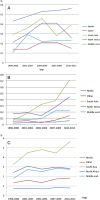Trends in diabetes in pregnancy in Sweden 1998-2012
- PMID: 27547412
- PMCID: PMC4985983
- DOI: 10.1136/bmjdrc-2016-000221
Trends in diabetes in pregnancy in Sweden 1998-2012
Abstract
Objective: Diabetes in pregnancy has been shown to increase in parallel with the increasing prevalence of obesity. In this national population-based study, we analyzed the trends for gestational diabetes mellitus (GDM), type 1 diabetes in pregnancy, and type 2 diabetes in pregnancy in Sweden between 1998 and 2012.
Research design and methods: A population-based cohort study using the Swedish national medical birth registry data. The time periods were categorized into 3-year intervals and adjusted for maternal body mass index (BMI), ethnicity, and age in a logistic regression.
Results: Each type of diabetes increased over the studied 15-year period. Type 1 diabetes increased by 33.2% (22.2-45.3) and type 2 diabetes by 111% (62.2-174.4) in the adjusted model. Nordic women had the highest prevalence of type 1 diabetes (0·47%) compared with other ethnic groups. The increase in GDM and, to a lesser extent, type 2 diabetes was explained by country of birth, BMI, and maternal age. The prevalence of GDM in Nordic women (0.7-0.8%) did not increase significantly over the time period.
Conclusions: All types of diabetes in pregnancy increased over the 15-year time period in Sweden. Maternal pre-pregnancy BMI remains the key factor explaining the increase in GDM/type 2 diabetes. How to turn around the growing prevalence of diabetes in pregnancy, with its short-term and long-term health effects on both mother and child, requires population-based interventions that reduce the likelihood of entering pregnancy with a raised BMI.
Keywords: Ethnicity; Gestational Diabetes Mellitus; Pregestational Diabetes; Pregnancy.
Figures
References
LinkOut - more resources
Full Text Sources
Other Literature Sources

